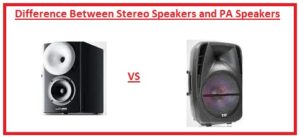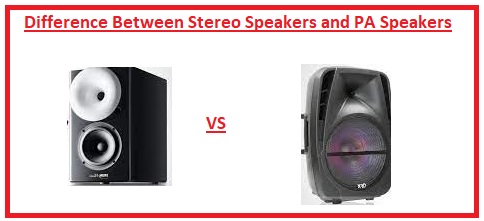 Hello readers welcome to new Post. Here we have an overview of Difference Between Stereo Speakers and PA Speakers. When you think about HiFi then can be confused by differnt types and many technologies. From the use of bi-wiring to sensitivity to floor stands and phono sections, we know that many of our customers find themselves looking for answers.
Hello readers welcome to new Post. Here we have an overview of Difference Between Stereo Speakers and PA Speakers. When you think about HiFi then can be confused by differnt types and many technologies. From the use of bi-wiring to sensitivity to floor stands and phono sections, we know that many of our customers find themselves looking for answers.
One of the most frequently asked questions from any AV supplier is what is the difference between stereo speakers and PA speakers, and what is suitable for business or school instution? So let get started
Difference Between Stereo Speakers and PA Speakers
- If we discuss the ‘stereo speakers’, these are types of speakers that we generally have in our homes They offer powerful and powerful sound, designed to bring the best to your music.
The way the stereo speaker does this varies from product to brand and from model to model, but generally you will find something new in the layout, cabinet design, magnetic layout and other variables.
For your business, they will work really well, but they may be more than the basic activities around the office, factory or school. Indeed, unless you plan to enjoy the music scene together, stereo speakers may not be the ideal choice for your business. Instead, you should look at the PA speakers.
PA speakers, or public address speakers, are used to make a loud, clear sound in a large area, such as an office. You will find them in many different places, from classrooms to factories and even nightclubs! Most importantly for us, however, they include the most amazing designs and are designed for a variety of purposes.
You will find that PA speakers can be subdivided into ‘main speakers’, which produce loud noise in the PA system, ‘subwoofers’ used to produce bass notes and ‘live monitoring speakers’, which artists use to hear their individual roles on stage.
In business and education, you will often use key speakers. There are two main types of PA speaker; performance and functionality. Active speakers require the use of a mixer to mix and send audio to them, while active speakers connect directly to electrical outlets and do not require additional computer equipment to produce sound.
Both have their distinctive advantages, with better sophisticated and more efficient audio setting speakers to be an easy choice for less expensive use cases, but both are ideal for education and business environments.
Stereo Speakers Vs PA Speakers
| Criteria | Stereo Speakers | PA Speakers |
|---|---|---|
| Design | Smaller, compact | Larger, more powerful |
| Configuration | Two speakers (L/R) | Multiple speakers (woofers, tweeters, subwoofers) |
| Sound Directionality | Stereo sound field | Directional projection |
| Frequency Response | Wide range (low to high) | Narrow range (midrange, high) |
| Power Handling | Lower power handling | Higher power handling |
| Sound Clarity | Clear, detailed sound | Loud, powerful sound |






